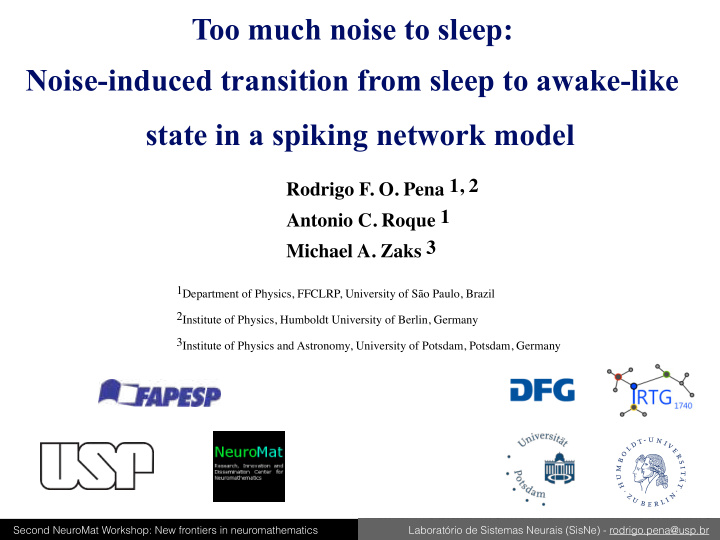



Too much noise to sleep: Noise-induced transition from sleep to awake-like state in a spiking network model Rodrigo F. O. Pena 1, 2 Antonio C. Roque 1 Michael A. Zaks 3 1Department of Physics, FFCLRP, University of São Paulo, Brazil 2Institute of Physics, Humboldt University of Berlin, Germany 3Institute of Physics and Astronomy, University of Potsdam, Potsdam, Germany Second NeuroMat Workshop: New frontiers in neuromathematics Laboratório de Sistemas Neurais (SisNe) - rodrigo.pena@usp.br
Different brains states Sleep Awake SWS or anesthesia Weak correlations - Cortical slice in vitro asynchronous - irregular Shu et al., Nature 423:288-293, 2003 In vivo recordings Renart et al., Science 327 , 587; 2010 Boustani et al., J Physiol (Paris) 101:99-109, 2007 Laboratório de Sistemas Neurais (SisNe) - rodrigo.pena@usp.br
10 Randomly connected 2 neurons Regular spiking Intrinsically bursting B A C RS IB Izhikevich’s formalism v = f ( v ) − u + I ( t ) ˙ (voltage) (recovery) u = a ( bv − u ) ˙ Chattering Fast spiking C D FS CH v ( t ) = v peak v ( t ) → c, u ( t ) → u ( t ) + d. Then Izhikevich, I EEE Transactions on neural networks, 2003 Low-threshold spiking Low-threshold spiking F Conductance-based synapses E LTS G ex/in X ( t )( E ex/in − v i ) I syn,i ( t ) = i/j j ✏ P resyn dG ex/in G ex/in ( t ) (t) i/j i/j δ ( t − t f X = − + g ex/in j ) dt τ ex/in t f j Laboratório de Sistemas Neurais (SisNe) - rodrigo.pena@usp.br
Ensemble of trajectories that leave to SSA Lifetime; network with LTS as inhibitory, 80%RS and 20%CH; g ex Rest g in If network correctly tuned, inhibitory conductance exceeds excitatory one: SSA; • C B Work published at Tomov, P., Pena, R. F., Zaks, M. A., & Roque, A. C. (2014). Sustained oscillations, irregular firing, and chaotic dynamics in hierarchical modular networks with mixtures of electrophysiological cell types. Frontiers in computational neuroscience , 8 . Laboratório de Sistemas Neurais (SisNe) - rodrigo.pena@usp.br
Activity is transiently self-sustained; • Sensitive dependence of individual trajectories on initial conditions; • Exponential distribution of lifetimes in the large ensemble of trajectories: • Typical raster plot Attributes of transient chaos Lai, Y. C., & Tél, T., Transient chaos: complex dynamics on finite time scales , 2011 Work published at Tomov, P., Pena, R. F., Zaks, M. A., & Roque, A. C. (2016). Mechanisms of self-sustained oscillatory states in hierarchical modular networks with mixtures of electrophysiological cell types. Frontiers in computational neuroscience , 10 . Laboratório de Sistemas Neurais (SisNe) - rodrigo.pena@usp.br
Transient Chaos Laboratório de Sistemas Neurais (SisNe) - rodrigo.pena@usp.br
Neurons are stochastic Spontaneous neurotransmitters release unreliable synapses Channel noise Lindner, B. (2016) Laboratório de Sistemas Neurais (SisNe) - rodrigo.pena@usp.br
Neurons are stochastic: synaptic noise I syn ( t ) = G ex ( t )( E ex − v ) + G in ( t )( E in − v ) G ex/in ( t ) √ ˙ G ex/in ( t ) = − + 2 D ξ ( t ) Point-conductance model described by Destexhe et. al., (2001). τ ex/in where we assume that the stochastic process ξ is Gaussian with h ξ ( t ) i = 0 and h ξ ( t ) ξ ( s ) i = δ ( t � s ). Laboratório de Sistemas Neurais (SisNe) - rodrigo.pena@usp.br
sleep 6 10 FS active FS active awake FS silent FS silent Resilience time [ms] LTS active sleep LTS active 5 LTS silent 10 awake LTS silent Noise influences transitions 10 Resilience time [ms] awake->sleep 4 10 sleep->awake 3 10 10 2 10 awake sleep 1 2.5 3 10 10 0.5 1 1.5 2 2.5 3 3.5 4 4.5 5 Amplitude D Amplitude D − 5 − x 10 Experiments measuring amplitude and frequency of mEPSC in the cerebral cortex of mice and rats show that these are: − − lower after a few hours of sleep, higher after a few hours of wake, higher after sleep deprivation. Rao et al., (2007), Liu et al., (2010) Laboratório de Sistemas Neurais (SisNe) - rodrigo.pena@usp.br
up down awake Power spectrum 1000 -5 PSD [1/s] 100 D=0.5x10 10 1 0 20 40 60 80 100 120 140 1000 -5 PSD [1/s] 100 D=1.5x10 10 1 0 20 40 60 80 100 120 140 1000 -5 PSD [1/s] 100 D=4.5x10 10 1 0 20 40 60 80 100 120 140 Frequency [Hz] Spectra agree with the literature; Young, Gerald A., et al. (1978): 89-91. Laboratório de Sistemas Neurais (SisNe) - rodrigo.pena@usp.br
Down state is influenced by: 40 (RS and FS) down (RS and FS) down Noise leveI Averaged resilience time [ms] 35 (RS and LTS) down (RS and LTS) down (RS and FS) up 30 (RS and FS) up Inhibition (RS and LTS) up (RS and LTS) up 25 20 15 10 5 0 0 0.5 1 1.5 2 2.5 3 3.5 4 4.5 5 − 5 D x 10 Experiments where inhibitory neurons are progressively blocked showed that inhibition influences up down transitions. Up − Sanchez-Vives, M. V, Journal of Neurophysiology (2010) Down Evidences showing that noise regulates up down transitions. Holcman, D. and Tsodyks, M. PLoS Comput Biol, (2006) Laboratório de Sistemas Neurais (SisNe) - rodrigo.pena@usp.br
Thanks for your attention Acknowledgement Laboratório de Sistemas Neurais (SisNe) - rodrigo.pena@usp.br
Recommend
More recommend